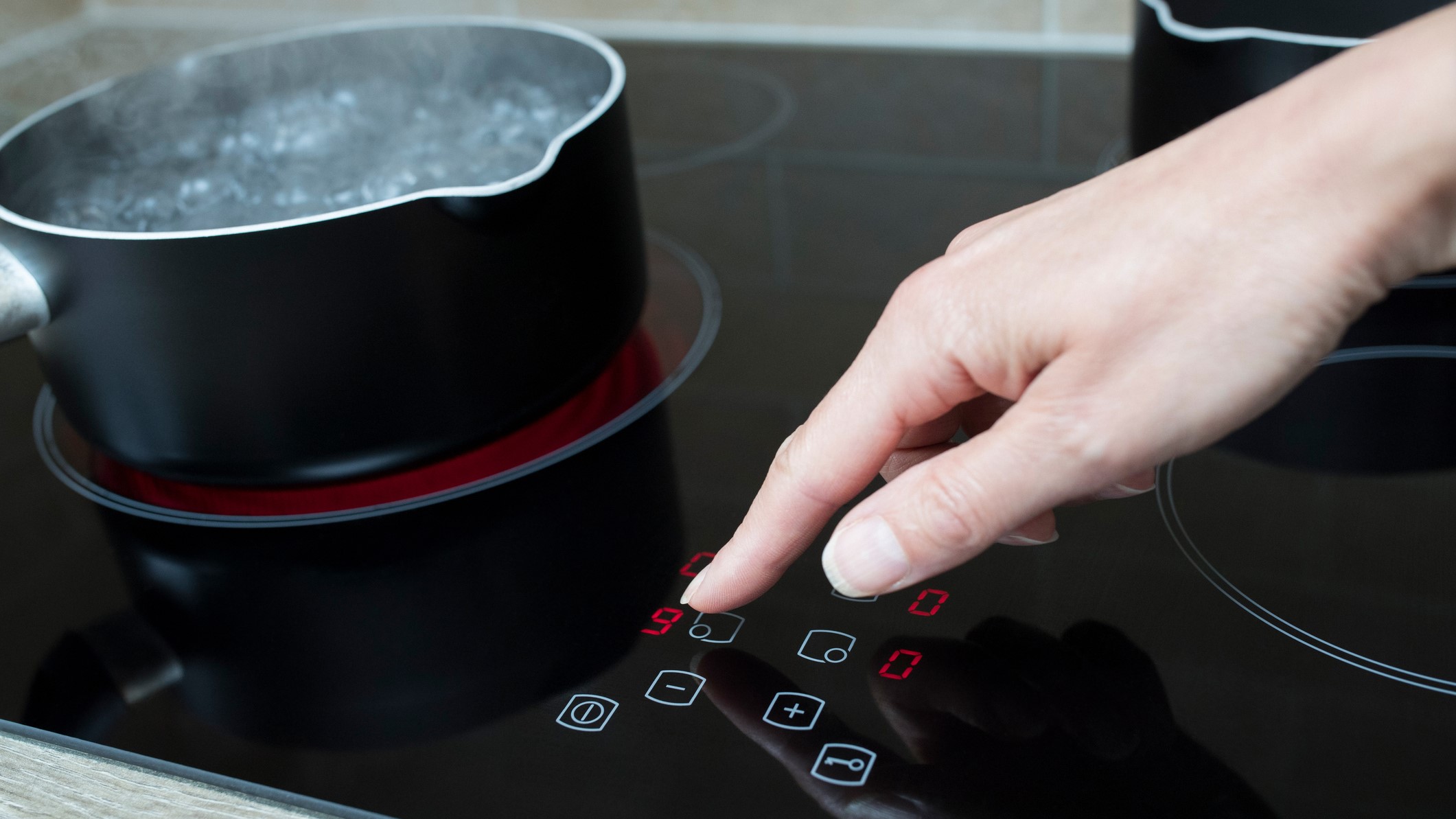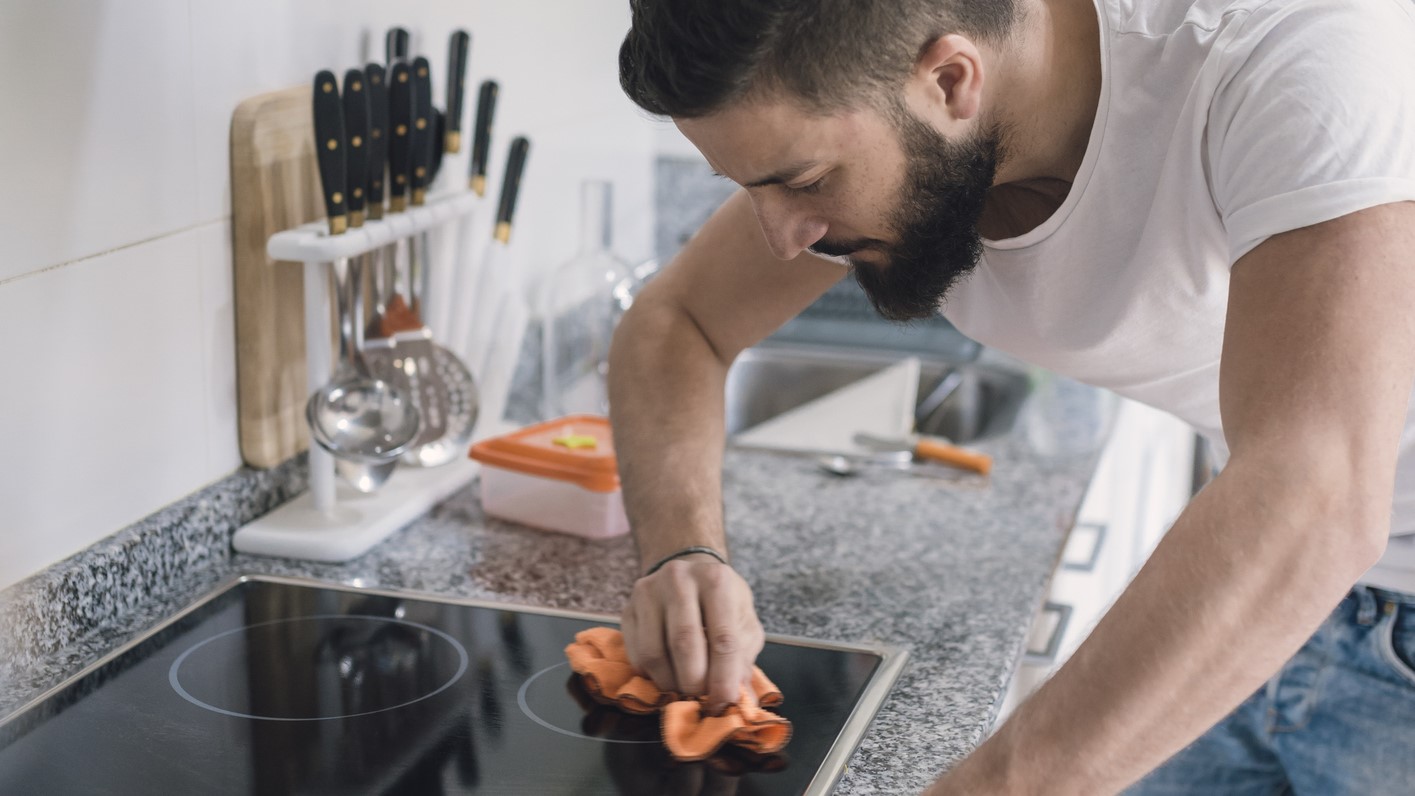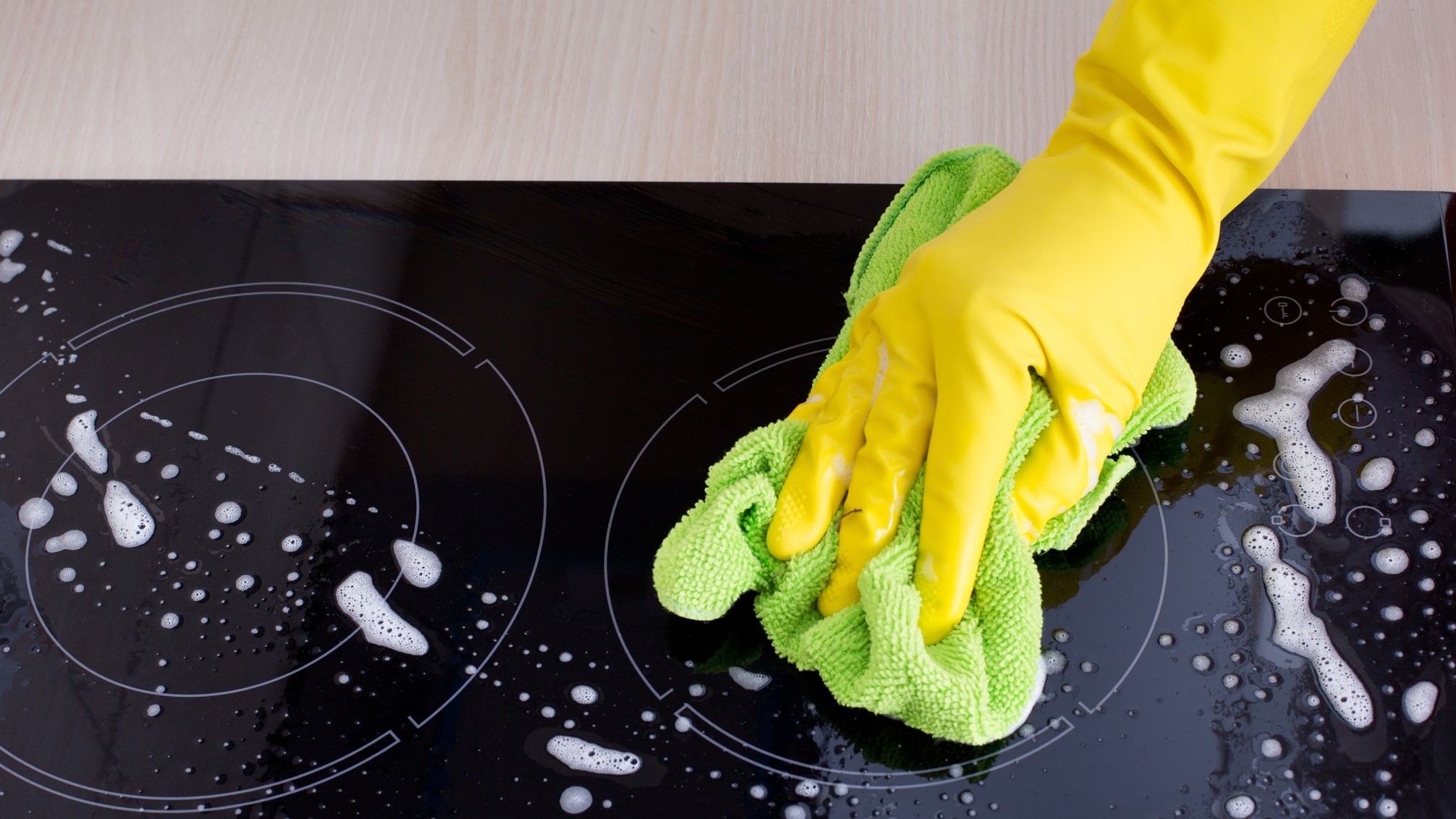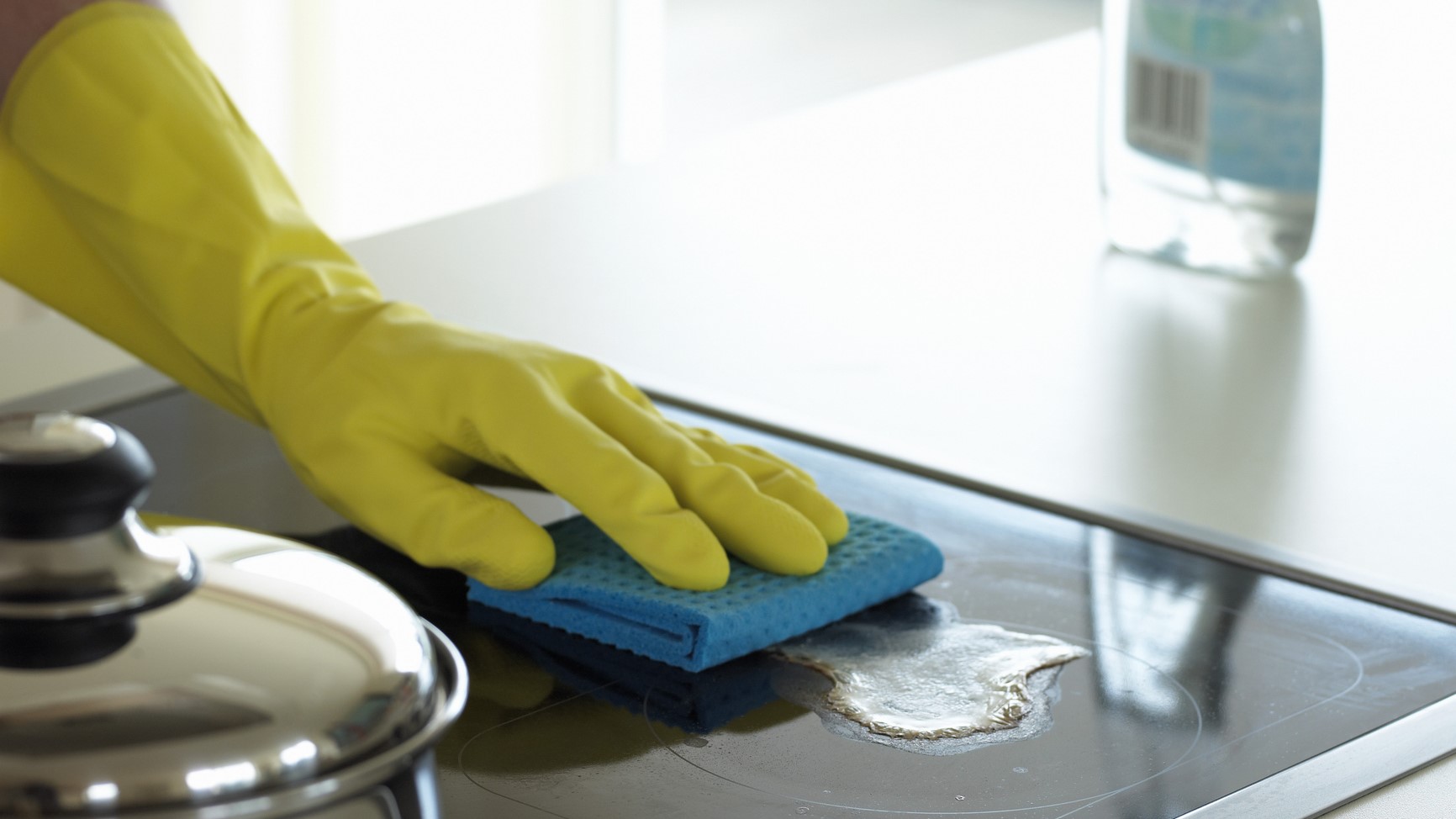Microfiber cloths or non-abrasive sponge
Mild dish soap
White vinegar
Baking soda
Plastic scraper
Branded electric cooktop cleaner (optional)
Cleaning your electric cooktop is simpler than you think with the right tools and techniques. These cooktops can quickly lose their sparkle when they accumulate grease, spills, and stubborn stains, but regular maintenance and the right approach will ensure they shine like new.
Before you begin, always check the manufacturer's user manual for specific care instructions for your cooktop, as cleaning requirements can vary depending on the model. Though many of these tips will work across different cooktop types, I'll focus on electric cooktops with a glass finish here.
I've also consulted one of my favorite and trusted cleaning experts for insider tips and advice on getting a sparkling finish.
How to clean an electric cooktop: quick steps
- Turn off and cool down the electric cooktop
- Remove crumbs and loose debris
- Use a plastic scraper for stubborn residues
- Clean with mild dish soap or a special cooktop cleaner
- Tackle stubborn stains with baking soda and vinegar
- Wipe down and buff for a streak-free finish
How to clean an electric cooktop: Step-by-step guide
1. Turn the power off and let your electric cooktop cool down

Before cleaning, always ensure the cooktop is turned off and completely cool. Electric glass surfaces can retain heat long after you’ve finished cooking, so it’s important to wait until it’s safe to clean. Attempting to clean while it's still hot could cause burns or damage to the glass.
2. Remove crumbs and loose debris

Start by wiping away any crumbs or food particles using a dry microfiber cloth or a soft brush. This prevents dirt from spreading around and scratching the glass surface as you clean.
3. Use a plastic scraper for stubborn residues
A plastic scraper works wonders for any burnt-on or stuck food. Gently scrape away the residue, always working at a 30-degree angle to avoid scratching the surface. Plastic is your friend here, as it’s tough on grime but gentle on your glass cooktop.
If you don’t have a designated cooktop scraper, a plastic spatula can also do the job. However, a specialized scraper is a great investment for those tough cleaning jobs, and you can pick one up for a few dollars at any hardware store or online.
If you're tempted to use a knife for scraping, think again. Ken Doty, a cleaning expert at The Maids, recommends avoiding anything too sharp to remove residue. "Never use sharp knives or objects to scrap away food residue," says Doty. "Instead, use a plastic scraper that has no chance of permanently scratching or damaging the cooktop."
Now, clean the area with a damp cloth to remove any leftover residue.

Ken Doty joined The Maids International in July 2013 as Vice President of Business Intelligence and was promoted to Chief Information Officer in February 2020. He is experienced in business intelligence with over 20 years of experience in consulting and information technology. He loves talking shop with other cleaning service professionals, and offering cleaning tips to anyone who asks!
4. Tackle stubborn stains with baking soda and vinegar
Vinegar and baking soda are powerful tools for tackling tough cleaning jobs around the home, especially stubborn stains on electric cooktops. For tough stains, Doty recommends spraying white vinegar directly onto the affected area and letting it sit for a few minutes to loosen the grime.
After the vinegar has had time to work, apply your usual cooktop cleaner or dish soap to wipe away the residue. Create a paste using baking soda and water for stubborn spots, then apply it to the stain. Finish by spraying the paste with your vinegar and water solution, which will help lift the grime even further, making it easier to wipe away.
5. Clean with mild dish soap or a special cooktop cleaner

Once the surface is free of large debris, mix a few drops of mild dish soap with warm water. Use a microfiber cloth to apply the solution across the cooktop. If you prefer a product made specifically for glass cooktops, you can use a branded cleaner, but dish soap is cheap and can do just as fine a job.
Spread the cleaner in a circular motion, ensuring even coverage. Let it sit briefly to break down grease and food particles before wiping it away with a clean, damp cloth. Doty suggests a minimum of 10-15 minutes to make your cleaner super effective. "Then rinse and wipe away any remaining cleaner with a damp microfiber cloth."
6. Wipe down and buff for a streak-free finish
Finally, after removing all the cleaning solution, use a clean, damp microfiber cloth to give your cooktop one wipe-down. Once the surface is free of any cleaner residue, take a dry cloth and buff the glass in circular motions. This will help prevent streaks and leave your cooktop gleaming.
For extra shine, you can apply a small amount of glass cleaner designed for electric cooktops to give the surface a polished, reflective finish.
Following these simple steps will keep your electric glass cooktop in great shape, ready for your next cooking adventure! Regular care will keep it looking brand new and ensure it performs at its best.
How to clean an electric cooktop: FAQs
Are electric cooktops scratch-proof?
While electric glass cooktops are made of durable and scratch-resistant material, they are certainly not scratch-proof. That's why it's crucial not to use abrasive sponges and wipes, such as steel wool, on the surface of your worktop. It's best to let your cleaner do all the heavy lifting and go easy on the elbow grease, so use soft microfiber cloths and allow your cleaner to work its way into dirt and residue for at least a few minutes before wiping away.
It's also important to ensure the surface is always free of coarse debris, such as peppercorns, salt flakes, herbs, etc. If these are dragged or slid across the surface, they can get trapped between the cookware and the glass and cause scratches.
Try not to worry too much if you make a small scratch, though, as these are often much less visible after cleaning.
What should I avoid when cleaning my electric cooktop?
As well as abrasive pads and scrubbers avoid these other practices and materials to prevent damage to the surface of your electric cooktop:
- Avoid harsh chemicals such as bleach, ammonia, or oven cleaners. These can damage your electric cooktop’s surface and leave harmful residues. Stick to mild dish soap, vinegar, or cleaners specifically designed for glass cooktops.
- Avoid using too much water or pouring water directly onto the cooktop, especially when it's hot. The excess moisture can seep into the edges or between the glass and the heating elements, which could damage the internal components.
- Avoid cleaners that contain wax or silicone, as these can leave a residue that is difficult to remove and can attract more dirt over time. Stick to cleaners designed for regular maintenance and shine.
- Avoid 'concentrated' cleaning solutions or solvents meant for industrial use, as they could damage your cooktop's glossy finish or cause discoloration.
- Avoid letting grease, spills, or food residue sit on the cooktop for too long. Remembering to clean immediately after cooking helps prevent staining and makes the process much easier in the long run.
Final thoughts
Maintaining the shine of your electric cooktop is simple when you follow a few easy steps. Clean up spills promptly, and use a microfiber cloth to sweep away crumbs. For regular cleaning, mild dish soap or a cooktop-specific cleaner is all you need to keep the surface spotless.
To prevent damage, avoid harsh chemicals, abrasive scrubbing tools, and heavy pots or pans. These can cause scratches or long-lasting marks. With consistent, gentle care, your cooktop will continue to look sleek and perform at its best.

